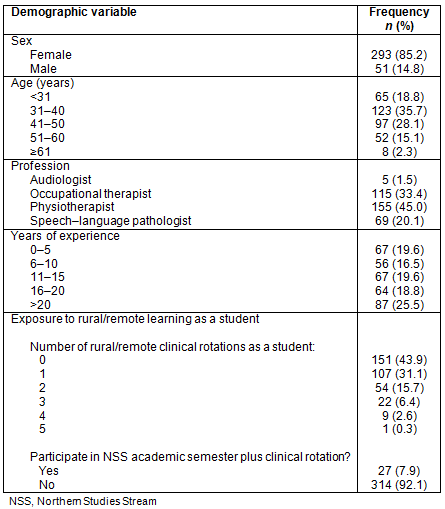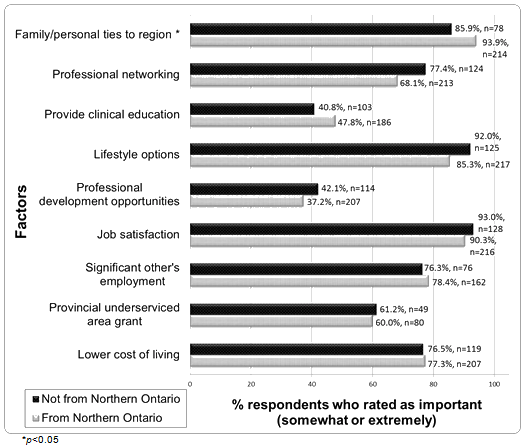Northern Ontario, a region with 87% of Ontario's land mass and only 6.5% of its population1, has historically been an underserviced area for healthcare2,3. In response, the Northern Studies Stream (NSS) and Rehabilitation Studies (RS) programs were created in the early 1990s through a joint initiative of Lakehead University in Thunder Bay, Ontario; McMaster University in Hamilton, Ontario; and the Ontario Ministry of Health.
Delivered through the campus of Lakehead University in Thunder Bay, the NSS Program is offered collaboratively through McMaster University and the Northern Ontario School of Medicine (NOSM). The NSS program provides academic and clinical education in Northwestern Ontario to McMaster University occupational therapy and physiotherapy students. The RS Program, administered by NOSM, provides clinical placements throughout Northern Ontario for audiology, occupational therapy, physiotherapy, and speech-language pathology students in partnership with other Ontario universities. The NSS and RS programs also support clinical faculty in Northern Ontario through continuing education, mentorship, and networking opportunities.
Previous literature in the field of medicine has demonstrated that exposure to rural learning increases a physician's likelihood of practising rurally post-graduation4-6. In addition, healthcare professionals (physicians, nurses, dentists, pharmacists, and rehabilitation professionals) originally from a rural or remote area were more likely to return to rural or remote practice settings following graduation5-7. There is little data exploring the recruitment and retention of rehabilitation professionals to rural or remote areas; however, the evidence suggests a link between exposure to rural learning and rural practice post-graduation8. Additionally, recruitment for occupational therapists and physiotherapists appears to be positively affected by close proximity to family, access to leisure and recreation activities, and the influence of a spouse9.
While some evidence suggests that the NSS Program has been effective in its recruitment and retention mandate7, current data do not exist regarding the factors that influenced the decision of rehabilitation professionals to move to and stay in Northern Ontario.
In this cross-sectional study, 605 rehabilitation professionals (audiologists, occupational therapists, physiotherapists, and speech-language pathologists) working in Northern Ontario were invited to complete an online survey (using SurveyMonkey) in June of 2009.
Respondents answered demographic questions and rated factors (educational, professional, lifestyle, financial) affecting their recruitment and retention to Northern Ontario. Factors were rated on a five-point Likert scale from 1 ('not at all important') to 5 ('extremely important').
Descriptive and frequency statistics were used to identify factors concerning a rehabilitation professional's likelihood to move to Northern Ontario to work and to remain on a long-term basis. Tests for statistical significance of recruitment and retention factors between those originally from Northern Ontario and those who were not were completed using χ² analysis.
Data were analyzed using the Statistical Package for the Social Sciences v17.0 (SPSS, Inc., http://www.spss.com).
A total of 345 individuals completed the survey (response rate: 57%). Amongst the total sample, there were 228 respondents (63%) originally from Northern Ontario and 117 respondents (37%) who were not. Additional demographic information of survey respondents is provided in Table 1.
When compared to datasets available for physiotherapists2 and occupational therapists3 in the areas of age and sex as well as number of individuals practising in the Northern Ontario region, the demographic information of survey respondents is highly similar, suggesting appropriate responsiveness amongst different demographic subgroups of the population of interest.
Results were separated into two categories: factors affecting recruitment and factors affecting retention.
Recruitment factors most frequently rated highly (Likert ranking ≥ 4 out of 5) amongst individuals originally from Northern Ontario were family/personal ties to the region, their Northern Ontario upbringing, the Ontario Underserviced Area Grant (UAG), and lifestyle options (eg outdoor activities, living in a smaller community). The UAG is an incentive program offered by the Ontario Government which provides a $5000 (Canadian funds) stipend for up to 3 years to individuals who choose to work in full-time, Ministry of Health-funded positions in Northern Ontario.
Amongst individuals not originally from Northern Ontario, the strongest recruitment factors included participation in rural/remote education via the NSS combined academic and clinical semester, lifestyle options, the UAG, personal employment opportunities, and spousal employment (Fig1).
Retention factors most frequently rated highly (Likert ranking ≥ 4 out of 5) amongst individuals originally from Northern Ontario were family/personal ties to the region, job satisfaction, lifestyle options, and Northern Ontario origin.
For those individuals not originally from Northern Ontario, retention was closely tied to job satisfaction, lifestyle options, family/personal ties to the region, and professional networking (Fig2).
Table 1: Demographic information about survey respondents


Figure 1: Factors affecting survey respondent recruitment to Northern Ontario.

Figure 2: Factors affecting survey respondent recruitment to Northern Ontario.
Discussion
This study revealed both anticipated and unexpected factors affecting the recruitment and retention of rehabilitation professionals to Northern Ontario.
As with previous research studying physicians, rural/remote origin as well as proximity to family were identified by Northern Ontario-raised individuals as strong factors associated with rehabilitation professional recruitment to Northern Ontario post-graduation. This contrasts with individuals not originally from Northern Ontario whose strongest recruitment factor was exposure to rural education via participation in the NSS Program. In combination with employment opportunities and lifestyle options, rural education appears to provide individuals not originally from Northern Ontario with sufficient incentive to relocate to the region following graduation. The importance of the NSS is therefore unsurprising as it exposes students not only to rural education but also to other identified recruitment factors such as positive lifestyle options and professional networking.
Receiving the UAG as well as positive lifestyle options were strong recruitment factors for individuals originally from Northern Ontario and those who were not. While the UAG was rated as an important recruitment factor, it was not an important retention factor. This may be due to the relatively short duration and low monetary value of the grant. It would appear that the UAG in isolation does not provide sufficient incentive for rehabilitation professionals to remain in Northern Ontario.
Interestingly, the multiple statistically significant differences in recruitment factors between individuals raised or not raised in Northern Ontario were not replicated in the area of retention. Job satisfaction and positive lifestyle options were important motivators for retaining therapists in Northern Ontario, regardless of their origin, with no statistically significant difference between these groups. Personal ties to the region were a strong retention factor for those individuals originally from Northern Ontario but also for those not originally from the region, indicating that these relationships were developed after they moved to Northern Ontario. The value of professional networking as a retention factor was moderately high amongst both groups and while it was a stronger factor amongst individuals not originally from Northern Ontario, this difference did not reach the level of statistical significance when compared to individuals originally from Northern Ontario (χ²(1)=3.4, p=0.067).
Limitations of this study include its cross-sectional design which eliminated the ability to examine any change in the identified recruitment/retention factors over time. Although general comparisons of demographic information amongst survey respondents and the population of interest were possible, the use of differing datasets made statistical comparisons impossible. Also, the use of broad rather than specific descriptors (eg 'lifestyle options') created the opportunity to interpret the question in different ways and may have resulted in either an underestimation or overestimation of the relative importance of these specific factors.
Educational institutions may wish to consider the selectively greater impact of the NSS academic and clinical semester on individuals not originally from Northern Ontario and whether this implies that selection for programs similar to the NSS should be preferentially given to those individuals not originally from a rural/remote area.
Employers and other funding agencies may wish to consider the importance of job satisfaction and professional networking as retention factors and how these may be best facilitated within the workplace.
Future research may include a longitudinal study examining graduates of the NSS and RS programs to determine the rate of recruitment and the factors affecting recruitment to rural/remote areas.
The disparity in workforce planning in the healthcare field between Northern and Southern Ontario is similar to that of many other rural and remote regions worldwide, so the results of this study may offer potential application to other underserviced rural and remote areas.
Acknowledgements
The study authors wish to thank Ms Marie Parkkari for her assistance with statistical analysis and Ms Liane Kandler, Ms Esmé French and Dr Joyce Tryssenaar for their editorial contributions to this manuscript.
References
1. Census of Population (Online). Available: http://www12.statcan.gc.ca/census-recensement/2006/index-eng.cfm (Accessed 15 November 2012).
2. Canadian Institute for Health Information. Physiotherapists in Canada, 2008. Ottawa: CIHI, 2009.
3. Canadian Institute for Health Information. Occupational therapists in Canada, 2009. Ottawa: CIHI, 2010.
4. McCready W, Jamieson J, Tran M, Berry S. The first 25 years of the Northwestern Ontario Medical Programme. Canadian Journal of Rural Medicine 2004; 9(2): 94-100.
5. Matsumoto M, Okayama M, Inoue K, Kajii E. Factors associated with rural doctors' intention to continue a rural career: a survey of 3072 doctors in Japan. Australian Journal of Rural Health 2005; 13(4): 219-225.
6. Daniels ZM, Vanleit BJ, Skipper BJ, Sanders ML, Rhyne RL. Factors in recruiting and retaining health professionals for rural practice. Journal of Rural Health 2007; 23(1): 62-71.
7. Richards HM, Farmer J, Selvaraj S. Sustaining the rural primary healthcare workforce: survey of healthcare professionals in the Scottish Highlands. Rural and Remote Health 5: 365 (Online) 2005. Available: www.rrh.org.au (Accessed 15 November 2012).
8. Cano J, Foster-Seargeant E. Educational preparation for rural and remote practice: the Northern Studies Stream. In: P Solomon, S Baptiste (Eds). Innovations in rehabilitation sciences education: preparing leaders for the future. Heidelberg, Germany: Springer-Verlag, 2005.
9. Solomon P, Salvatori P, Berry S. Recruitment factors by therapists in Northwestern Ontario. Canadian Journal of Rural Medicine 2001; 17(3): 278-285.


